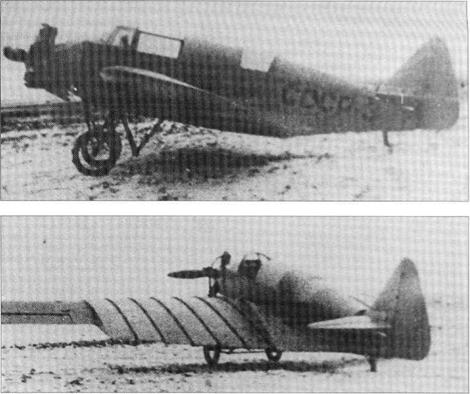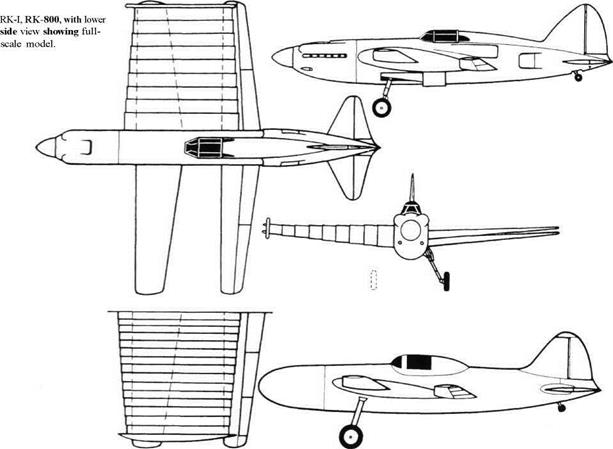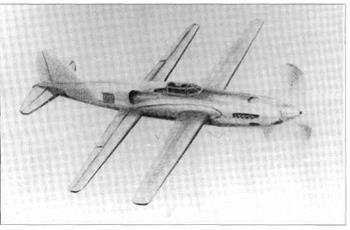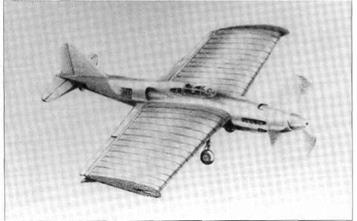NIAI RK, LIG-7
Purpose: To evaluate an aeroplane with a wing of variable area.
Design Bureau: NIAI, Leningrad.
In 1936 Grigorii (according to Shavrov, Georgii) Ivanovich Bakshayev, aged 18, joined the UK GVF, the instructional combine of the civil air fleet. He was eager to test his belief that a superior aeroplane could be created by arranging for it to have a large wing for take-off and landing and a smaller wing for cruise. As the UK GVF was in Leningrad the NIAI adopted the idea. Called RK (Razdvizhnoye Krylo, extending wing), and also LIG-7 because it was the seventh project of the Leningrad Institute GVF, the aircraft was built quickly and was first flown in August 1937. Remarkably, the
system worked smoothly and reliably (better in the air than on the ground), and it led to the evenmore unconventional RK-I fighter.
Apart from the wing the RK was a simple monoplane of mixed construction, with enclosed cockpits for a pilot and observer and powered by an uncowled l00hp M-l 1 engine driving a laminated-wood propeller. It had a two-spar wing of constant narrow-chord M-6 profile, braced by pairs of wires above and below to the top of the pilot’s hood and to a pyramid truss under the fuselage. At the root was what looked like the root section of a much larger wing, with CAHI (TsAGI)-846 aerofoil profile, but with a span of only 50cm (1ft 7%in). Inside this, nestling tightly like a set of Russian Matroshka dolls, were five further
plywood wing sections each of 50cm span. The observer could crank these out by a cable mechanism, each adding 45cm (1ft 5%in) to the span of the large-chord region. It took 30 to 40 seconds to crank the telescopic sections out to their full extent, covering 60 per cent of the semi-span, and 25 to 30 seconds to wind them back.
Seemingly a ‘crackpot’ idea, the RK performed even better than prediction. It is difficult to account for the fact that it got nowhere. The answer must be that it introduced an element of complexity and possible serious danger, sufficient to dissuade any later designer from following suit.
 |
 |
Purpose: To create a fighter with variable wing area.
Design Bureau: NIAI, Leningrad.
From the start of his telescopic-wing studies young Bakshayev had really been thinking about fighters. He had regarded the RK merely as a preliminary proof-of-concept exercise. He calculated that a fighter able to retract most of its wing area and powered by the M – 105 engine ought to be able to reach a world – record 800km/h (497mph), overlooking the fact that a fighter with a relatively small wing would have poor combat manoeuvrability. Indeed, as described below, he found a way to make the relative difference between the small and large wings even greater than in the RK, the ratio of areas being 2.35:1. In October 1938 he submitted a preliminary design sketch for the RK-I (Russian abbreviation for extending-wing fighter). After much argument the concept was accepted by CAHI (TsAGI) and the WS. A one-fifth-scale model was tested in a CAHI (TsAGI) tunnel from January 1939, but it was difficult to find an industrial base capable of building even the prototype. Worse, the RK-I attracted the attention of Stalin, who took a keen interest in combat aircraft. Excited, he demanded that this aircraft should use the M-106 engine, the most powerful then on bench test. Under
some difficulty a prototype RK-I was completed in early 1940, but the M-106 engine (later designated VK-106) was still far from ready. The aircraft could have flown with the M-105, but nobody dared to fit anything but the engine decreed by Stalin. In order to do at least some testing a full-scale model was constructed with the nose faired off, fixed landing gears and a projecting canopy, with no attempt to simulate armament or the radiator ducts in the rear fuselage. This mock-up was then tested in the CAHI (TsAGI) full-scale tunnel. The resulting test report was generally favourable, but noted that sealing between the telescopic wing sections was inadequate. The CAHI (TsAGI) aerodynamicists nevertheless concluded that with the M-106 the speed might be 780km/h (485mph). Lacking an engine the project came to a halt, and after the German invasion in June 1941 it was abandoned. Bakshayev was appointed to supervise increased production of the 156km/h (97mph) U-2 (Po-2) at Factory No 387.
The lifting surfaces of the RK-I were unique, and quite unlike anything attempted by any other designer. The aircraft was all-metal, the large fuselage being a light-alloy monocoque which would have housed the 1,800hp M-106 in the nose with the oil cooler underneath and surrounded by two 20mm ShVAK cannon and two 7.62mm ShKAS machine guns.
Behind the firewall were successively the fuel tanks, backwards-retracting single-strut main landing gears, enclosed cockpit and the glycol coolant radiator with controllable air ducts on each side of the rear fuselage. The amazing feature was that there were two wings of equal span and narrow tapering chord, one in front of the cockpit and the second, set at a slightly lower level, behind. Each had upper and lower skins of spot-welded SOKhGSA stainless steel, and the rear wing was fitted with three hinged trailing-edge surfaces on each side serving as flaps and ailerons. These movable surfaces, like the tail, were made of light alloy. The unique feature was that on this aircraft the root of the large wing extended completely around the front wing and back almost to mid-chord of the rear wing. Nested inside it were 14 further wing profiles, which in 14 seconds could be winched out over the entire span by an electric motor and cable track along the rear wing leading edge, which was at right angles to the longitudinal axis. Each section of the large wing comprised a Dural leading edge and rib with a fabric skin, the first section sealing the side of the fuselage in the high-speed condition and serving as a wing end-plate in the extended low-speed configuration. Shavrov gives the weight of all 28 telescopic sections as approximately 330kg (727.5 Ib). Changing
|
|||||||||||
|
|||||||||||
|
|||||||||||
|
|||||||||||
|
|||||||||||
|
|||||||||||
|
|||||||||||
|













